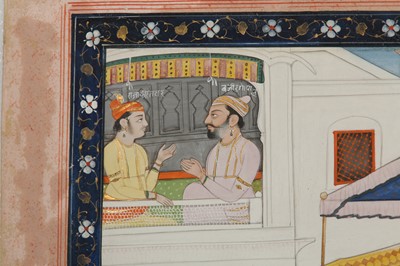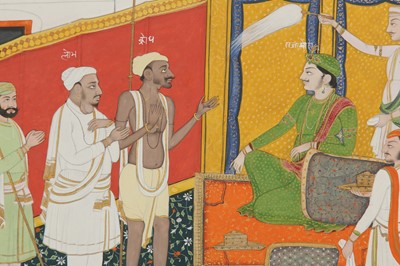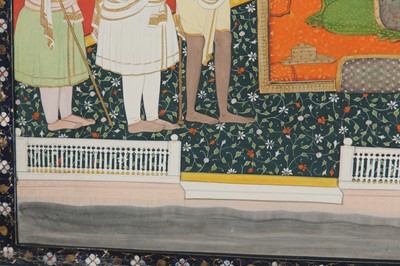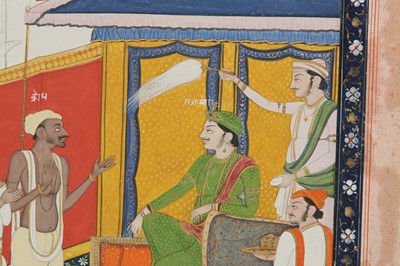16th Jul, 2021 12:00
Islamic & Indian Paintings: The Dexter Collection Part II
A CHASTISEMENT SCENE AT A RULER'S COURT
Possibly Guler artist in Kangra, Pahari Hills, Northern India, ca. 1820 - 1830
A CHASTISEMENT SCENE AT A RULER'S COURT
Possibly Guler artist in Kangra, Pahari Hills, Northern India, ca. 1820 - 1830
Opaque pigments heightened with gold and silver on paper, the vertical composition depicting an allegorical chastisement scene of lobh (greed) and krodh (anger) shown standing in front of a richly dressed king wearing a green robe and turban, King Mohor (?), each character accompanied by a caption in white ink Devanagari script to identify them, Lobh portrayed as a chubby gentleman with a very protruding and bulging laryngeal prominence (Adam's apple), possibly a hint at his avarice, and Krodh portrayed arguing with the king, the edges of his eyes painted in red, the archetypical colour for anger, in the upper left corner a balcony scene with a young Sikh king with an orange turban, Raja Kirtanwar, debating with his pink-clad advisor Vajir Gopal, the scene encased within typical Kangra school borders with white and yellow flowers against a dark blue background, red rules and red-speckled pink borders, the recto with later annotations in pencil and red pen, 28.7cm x 24cm.
This painting can be considered as a partner scene, or most probably another illustration part of the same series already offered in April in these Rooms, 16 April 2021, lot 369, THE SADHU'S ARRIVAL FOR THE PUJA TO BEGIN. The use of bold primary colours, the characterisation of each subject, the attires and the setting all appear to be very similar. Perhaps, both paintings were once part of a Pahari Hills princely series illustrating the do's and don'ts of a young prince, similarly to the Medieval Specula Principum or Mirrors for Princes. A genre of advice literature outlining basic principles of conduct for rulers and of the structure and purpose of their secular power, these were incredibly popular in the Islamic World, especially in Persia.
Guler and Kangra were two of the most prominent schools of Pahari paintings, and to this day their productions are very sought-after and collected all around the world. Guler was administered by Sikh rulers from 1813 until 1849, when following the Second Anglo-Sikh War it officially became part of the British district of Kangra. It was specifically during this period that accomplished Guler artists were commissioned by wealthy Sikh patrons to paint in a special Sikh style, developed further in Adinangar, Lahore and Amritsar's later productions. For further reference, please see W. G. Archer, Paintings of the Sikhs, 1966 and W. G. Archer, Indian Paintings from the Punjab Hills, 1973, Vol. 1, pp. 129 - 133.
Sold for £1,062
Includes Buyer's Premium
Do you have an item similar to the item above? If so please click the link below to submit a free online valuation request through our website.





